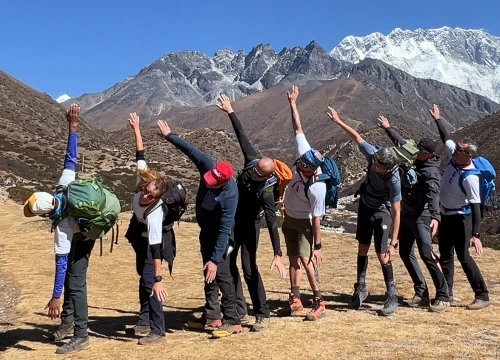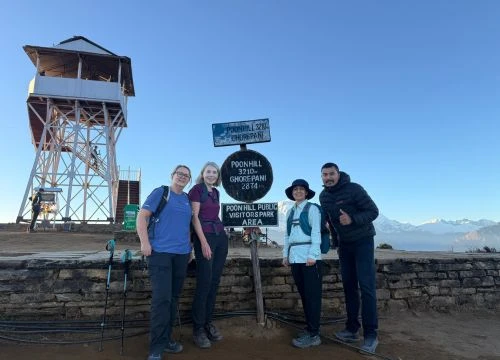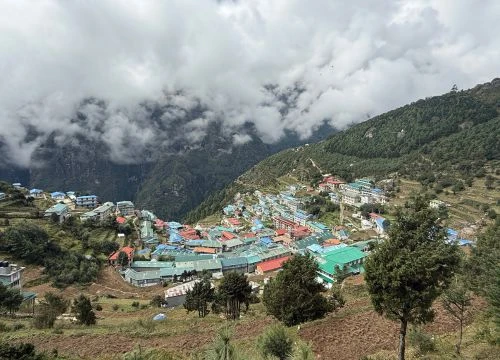White Monastery
The White Monastery (Seto Gumba) is also known as Druk Amitabh Mountain. It is a Nepalese Buddhist monastery that is situated in the Nagarjun Municipality of the Kathmandu District. It is located apart from the Ring Road, north of Swayambhu. For people in Kathmandu, it is the nearest and best destination to view the sunrise and sunset from a hill. You will see the most magnificent and breathtaking sunrise or sunset from this location. It's impossible to resist taking a picture since the white monastery's architecture is so distinctive and stunning.
The monastery used to be accessible to the general public on Saturdays, but since the 2015 earthquake, it has been closed for renovation. But it is now accessible to the public on Sundays, so you may go there and take in the tranquility of the surroundings. As public transportation is prohibited in the gumba, you can only get to the white monastery by biking or hiking from Shoyambhu. Hiking will take around an hour, while biking will take about 20 minutes. If you don't have a bike and are too lazy to walk, getting a cab is also a good option to get to the White Gumba. You can engage in activities like hiking, biking, sight-seeing, photography, and meditation if you are planning on visiting the White Monastery.
Swayambhunath Stupa
The Swayambhunath Stupa also referred to as the Monkey Temple, is one of Kathmandu's most iconic attractions. One of Kathmandu's historic Buddhist stupas, it gives magnificent views of the city from atop a hill. The stupa is made out of a dome at the bottom and a cube-shaped construction with Buddha eyes painted on it from all four directions. In addition, it is surrounded by a number of smaller Tibetan temples, various monasteries, praying flags, museums, and libraries.
The Swayambhunath stupa is situated in the center of Nepal's capital, Kathmandu. So, it may be so conveniently located that everyone may reach it by taking a public bus. There are two ways to enter the site: one is from the top of the hill to the east, where a steep stairway descends to the temple's main platform. The south entrance is accessible through a vehicle road that rounds the hill. The Vajra is the first thing you see as you get to the top of the stairs. The stupa is accessible to the public every day.
Boudhanath Stupa
This Boudhanath stupa, which is a UNESCO World Heritage Site, is one of the biggest spherical stupas in the world. It is among the top tourist destinations in the Kathmandu valley, along with Swayambhu. It is also recognized as Nepal's oldest stupa, having religious significance and beliefs. The Newar and Tebatan Buddhist communities, in particular, have historically and traditionally contributed much to this place. Several monasteries and stores that offer traditional Buddhist goods can be found in the area around the stupa.
The Boudhanath stupa is located approximately 11 kilometers northeast of Kathmandu's city center.This location is always accessible to the public, so you may go there whenever you choose. The road can be reached from anywhere in Kathmandu, which is also reachable by public bus.
Kopan Monastery
Kopan is a Tibetan Buddhist monastery with a view of Kathmandu that is renowned for its retreats and classes in meditation. People travel to the popular Kapan monastery in Kathmandu for spiritual retreats lasting a whole week. You may take a tour of the lovely location and discover some inner tranquility while doing so.
Kapan monastery is located on the hill of Kapan, just north of Boudhanath. The distance from the city is around 15 kilometers, and access to the monastery is always available. Public transportation and private vehicles are the best modes of transportation to reach the top of the hill. Another simple and quick method to get to the monastery is by mountain bike or by hiring a cab. As an alternative, if you enjoy hiking, you may walk there from the bouddha in around 45 minutes.
In addition, after seeing Kopan monastery, you may visit the Phulhari Monastery. Phulhari gumba is located on a hilltop that is higher than Kopan monastery, whose construction combines elements of the east and west. The hike to Phulhari takes less than an hour from Kapan, which is worth a visit for the beautiful Thangka paintings.
Namo Buddha Monastery
The Namo Buddha Monastery, also called Thrangu Tashi Yangtse Monastery, is situated about 40 kilometers (by road) southeast of Kathmandu, the capital of Nepal. This monastery is believed to be the site where Buddha sacrificed his body to feed a starving tigress and her cubs. The monastery itself resembles a stunning palace with its Tibetan Buddhist monastery architecture, which has roofs with gleaming golden arches and is covered in colorful prayer flags.
Namobuddha is one of the most stunning places and a major tourist attraction. It is located at the top of a hill in Namobuddha Municipality. It takes around two hours to get there from Kathmandu by bike, minibus, or cab. It's a popular pilgrimage site that provides breathtaking views of the Himalayas.
Shechen Monastery
Shechen Tennyi Dargyeling Monastery, which was established in the 17th century, is renowned for its exquisite paintings and conventional Tibetan architecture. This monastery is one of the most wonderful examples of Tibetan art, which was created by expert goldsmiths, stonemasons, sculptors, painters, and tailors. This monastery houses is a huge collection of old Buddhist literature or texts (one of the largest Tibetan libraries in the east) in addition to more than 150 statues.
Furthermore, there are places of spiritual stillness, inspiration, and prayer that provide a setting for reflection and study. The monastery is accessible to the public from 9 a.m. to 5 p.m. and is situated to the northeast of Boudhanath. It is around 10 kilometers from the airport, and you may get there by bus, bike, or taxi. The path to Shechen monastery is so peaceful and serene that you could even hike along it.
Pharping Monastery
Pharping monastery is situated near the town of Pharping, some 23 kilometers southwest of Kathmandu. Many significant Buddhist pilgrimage sites, monasteries, and retreat centers can be found in Pharping. It's famous for the holy cave where Guru Rinpoche is supposed to have meditated. It is a popular destination for both tourists and local pilgrims.
The Asura Cave, Hand Prints, Special Pictures, Yangleshö Cave, Vajrayogini Temple, and many more places are also nearby for exploration or viewing.
Conclusion
Monasteries are places of spirituality and pilgrimage in several Buddhist traditions. It offers assistance in the doing of circumambulations, offerings, and prostrations. They contain rare monuments and texts, particularly when they are strategically located in major geographical areas.As a result, the creation of a monastery is preferable in Kathmandu and other Nepalese locations since they have innate strength and induce tranquility. These gumbas are dedicated as a living, enlightened presence rather than as a material structure. As a result, it benefits not just the area where it is located but also the entire world.
These are just a few of the top monasteries in Kathmandu, and there are many more to explore throughout the city and surrounding areas. Similar to this, some monasteries offer or provide certain courses and encourage individuals to explore more knowledge. You are free to join in their classes, go on a retreat, or spend some time alone for meditation or self-study. Even though you have the choice to begin or end your course or retreat by adding an extra day or two.




